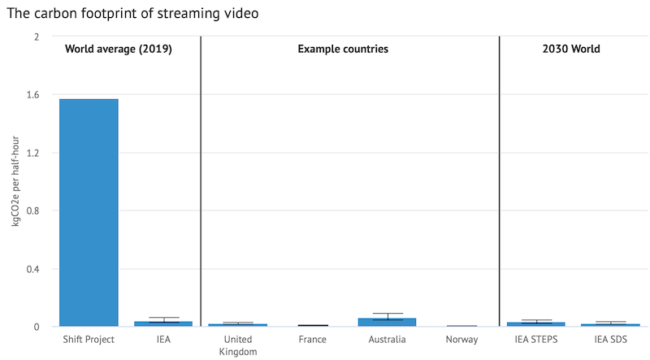
A spate of articles published within reputable media outlets all repeat the claim that streaming Netflix will have a rather large CO2 impact.
Here are some examples …
- Phys.Org (Oct 2019) – Chill your Netflix habit, climate experts say …
- “experts say the ease of streaming services comes with a hefty environmental price tag … …Watching a half-hour show would lead to emissions of 1.6 kilograms of carbon dioxide equivalent, said Maxime Efoui-Hess of French think tank the Shift Project. That’s equivalent to driving 3.9 miles (6.28 kilometres).“
- Gizmodo (July 2019) – Your Binge-Watching of Netflix and Porn Is Contributing to Millions of Tons of Emissions a Year …
- “group of analysts from The Shift Project, a Paris-based think tank dedicated to a low-carbon future, has concluded in a report that all online videos from around the world emit over 300 million tons of carbon dioxide a year. That’s 1 percent of the total annual global emissions.“
- New York Post (Oct 2019) – Why climate change activists are coming for your binge watch
- “Researchers estimate that watching a half-hour show via an on-demand video app emits 1.6 kilograms of carbon dioxide into the environment — the equivalent of driving almost 4 miles, according to Maxime Efoui-Hess of Paris-based nonprofit the Shift Project.“
- Guardian (Feb 2020) – The real problem with your Netflix addiction? The carbon emissions
- “We may feel that we are consuming less thanks to the internet, but digital technologies account for more carbon emissions than the aerospace industry, according to a study by the Shift Project, a Paris-based thinktank“
- etc…
The Alpha Source
Note that they all cite a report by the French Shift project. The report in question is this one that was published in July 2019 …
“CLIMATE CRISIS: THE UNSUSTAINABLE USE OF ONLINE VIDEO”
The environmental impact of digital technology is now recognized as unsustainable, but continues to grow. The energy consumption of digital technologies is increasing by 9% a year, and already represents% of global greenhouse gas emissions. The use of digital technology accounts for 55% of its energy consumption, compared to 45% for the production of equipment. This was demonstrated by our report “Lean ICT – Towards digital sobriety” published in 2018.
The essence of their claim is that streaming was responsible for more than 300m tonnes of CO2 (MtCO2) in 2018.
The Fatal Flaw here
The media narrative leans upon this Shift report, so the real question to ask is if this report is robust and solid.
Much of what the report articulates rests upon a 2015 paper titled “On Global Electricity Usage of Communication Technology: Trends to 2030”. They have combined that with a set of assumptions and ended up unintentionally exaggerating the energy consumption.
How wrong?
Are they a tiny bit wrong?
Nope they are many orders of magnitude wrong …. 30 to 60 times wrong.
Flaw 1 – Their estimated Bitrate for streaming is wrong
it overestimates bitrate, the amount of data transferred each second during streaming, apparently assuming a figure of 24 megabits per second (Mbps), equivalent to 10.8 gigabytes (GB) per hour. This is six times higher than the global average bitrate for Netflix in 2019 (around 4.1 Mbps or 1.9 GB/hr, excluding cellular networks) and more than triple the transfer rate of high-definition (HD, 3 GB/hr). Other typical transfer rates are 7 GB/hr for ultra-high definition (UHD/4K) and 0.7 GB/hr for standard definition (SD).
Exactly how did they get that wrong?
They accidentally interpreted 3Mbps as 3 Mb per second. Bits and bytes are not the same thing. A byte is 8 bits.
Flaw 2 – They got the datacenter Energy intensity wrong
the Shift Project analysis overestimates the energy intensity of data centres and content delivery networks (CDN) that serve streaming video to consumers by 7- to 18-fold, relative to figures derived from 2019 Netflix electricity consumption data, Cisco traffic data and IEA analysis.
Flaw 3 – They got the Energy intensity of networks wrong
the Shift Project overestimates the energy intensity of data transmission networks by 6- to 17-fold. This is the result of high energy-use assumptions for various access modes – for example, 0.9 kWh/GB for “mobile” compared to my estimate of 0.1-0.2 kWh/GB for 4G mobile in 2019. The Shift Project also assumes a higher share of data transfer through more energy-intensive mobile networks compared to WiFi, which it puts at one-third of the total compared to less than 10% based on Netflix data.
Flaw 4 – They got the energy consumption of devices wrong
This actually works the other way …
the Shift Project underestimates the energy consumption of devices by some 4- to 7-fold, because it assumes that viewing occurs only on smartphones (50%) and laptops (50%). According to Netflix, 70% of viewing occurs on TVs, which are much more energy-intensive than laptops (15% of viewing), tablets (10%), and smartphones (5%).
Implications of all these flaws soon adds up
streaming a Netflix video in 2019 typically consumed 0.12-0.24kWh of electricity per hour, some 25- to 53-times less than estimated by the Shift Project
In other words, your own personal choices such as what device you use, what network you use to access streaming, and what resolution you pay for, will all greatly influence the actual CO2 footprint.
So what is the actual Netflix CO2 footprint?
Many of the media stories citing this report utilise 30 minutes of Netflix as their measuring rod. Let’s use that.
- Lean upon the Shift report and that 30 minutes of Netflix translates into 1.6 Kg of CO2.
- Recalculate by correcting their flawed assumptions and that 30 minutes of Netflix instead becomes 0.028-0.057kgCO2e (That is 28-57 grammes)
Here is an illustration of this from carbonBrief …

Driving Distance metric
The other illustration used is driving distance for a conventional car. Let’s also correct that measuring rod.
- Lean upon the Shift report and that 30 minutes of Netflix translates into driving 4 miles (6.4 kilometres).
- Recalculate by correcting their flawed assumptions and that 30 minutes of Netflix instead translates into driving around 200 metres
Turtles all the way down
It gets complicated.
Assumptions are also built upon prevailing conditions at a point in time. Yes, you can make calculations for the CO2 footprint of power consumption, but what is neglected in such calculations is that the actual CO2 impact will vary from nation to nation. What also happens is that as time passes the power industry is rapidly transitioning in many places to clean renewable sources …
emissions intensity of electricity in the UK fell by nearly 60% between 2008 and 2018. Compared to 2018 levels, global emissions intensity of electricity falls by around one-fifth by 2030 in the IEA Stated Policies Scenario and by half in the Sustainable Development Scenario.
But demand is rising
Indeed it is. However, coupled with a rising demand is also a rapidly rising degree of efficiency. This makes it immensely challenging to quantify the net environmental impacts over time.
Goals
Make no mistake here. The goal of the Shift project is to make a case for moving to a post-carbon economy. That is to be applauded, it truly does merit your strong support.
Truth and accuracy does also matter.
The Shift project have no nefarious deception in play, it is simply an honest mistake. Making such calculations is deeply challenging, so much so, that you are often forced into making assumptions. If however you get your assumptions wrong then your conclusions will also be wrong. In this case many orders of magnitude wrong.
Final word
The CarbonBrief debunking of the flawed Shift report sums things up as follows …
Streaming video is a fairly low-emitting activity, especially compared to driving to a cinema, for instance. As consumers, we can further reduce our environmental footprint by streaming at lower resolutions, using smaller devices and screens, as well as connecting through WiFi instead of mobile networks. Replacing devices less often can also help, since production accounts for more than two-thirds of the lifecycle carbon emissions of mobile devices, and electronic waste is a growing problem across the world.
…
What is indisputable is the need to keep a close eye on the explosive growth of Netflix and other digital technologies and services to ensure society is receiving maximum benefits, while minimising the negative consequences – including on electricity use and carbon emissions.
Instead of relying on misleading media coverage, this will require rigorous analysis, corporate leadership, sound policy and informed citizens.
Netflix and CO2 – Further Reading
- Carbon Brief (25th Feb 2020) – Factcheck: What is the carbon footprint of streaming video on Netflix?
- This is a very detailed debunking of the Shift report by George Kamiya, a digital/energy analyst at the International Energy Agency in Paris.
